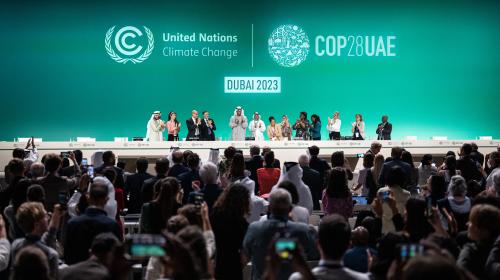Protesters gathered on Earth Day in over 500 cities across the world to participate in the March for Science to celebrate innovation and demand evidence-based policymaking. One week later, tens of thousands marched in Washington, DC and other cities in the People’s Climate March to demand action on climate change and confront denialism in the Trump administration. Climate change and other global scientific challenges threaten global health, resource scarcity, and national security. New understanding of climate change and infectious disease has produced a number of intriguing potential solutions that might mitigate long-term negative consequences for humans and the environment. With increasing desperation, scientists are pursuing aggressive solutions to combat climate change and infectious disease.
However, like the issues they address, these technological solutions might have consequences that require new forms of international governance to mitigate risk. These governance issues must be addressed before emerging technologies are deployed to combat climate change and infectious disease.
Engineering the Global Climate
Faced with potential changes to U.S. engagement in global climate change initiatives, scientists are exploring the possibility of manipulating the atmosphere to manage solar radiation. These experiments involve a form of geoengineering: spraying microscopic particles into the atmosphere that either reflect sunlight or limit cloud coverage that traps heat. Dr. David Keith, who will lead a geoengineering field experiment in 2018, predicts that these initiatives might limit global temperature increases in a cost-effective manner.
While evidence in ice cores and other geological records indicate human activity is driving climate change, computer models simulating geoengineering have many constraints. Primarily, the simulations fail to evaluate geoengineering’s ramifications for atmospheric phenomena such as ozone depletion and precipitation. Furthermore, there is no available data on how large-scale deployments might affect seasonal weather patterns or exacerbate natural disasters.
There is even less certainty of how to govern such planetary endeavors. A 2010 resolution from the UN Convention on Biodiversity essentially banned geoengineering projects except small-scale scientific research. Notably, the United States was not a signatory to the resolution. There are currently no international laws or regulations with enforcement mechanisms preventing countries from deploying geoengineering strategies. Leaving regulation to individual countries would allow scientists to secure funding and conduct research in one country and then conduct field experiments in countries lacking regulatory mechanisms, with consequences that affect countries an ocean away.
While there have been few violations of the UN resolution, there is no governance system in place to scale up deployment or have authority to end a project. The Carnegie Council launched the Carnegie Climate Geoengineering Governance Initiative in February 2017 to engage stakeholders from the government, non-profit, and private sector in policy discussion. Led by Janos Pasztor, the former UN assistant secretary-general for climate change, the program plans to create tools that might be a part of a multilateral governance framework.
Gene Drives Crossing National Boundaries
Advances in gene drive technology have also prompted a discussion of the appropriate governance for potentially transnational issues. Normal genetic inheritance gives each parent’s genes about a 50% chance of being passed onto each offspring. Gene drive technologies artificially “drive” a gene to be passed along to all offspring through sexual reproduction. This manipulated inheritance pattern allows the gene to spread within a population in only a few generations and cause changes to the population’s biodiversity.
Researchers are preparing to deploy the technology in Africa to manage mosquito populations that transmit malaria. One gene alteration could produce successive generations that are almost exclusively male, which do not bite humans and produce a gender imbalance that would limit reproduction. Despite the clear benefits, there are similar concerns that large-scale deployment might have enormous implications that transcend political boundaries. Controlled experiments in laboratories fail to reveal the unintended consequences of gene drives, such as transmission to other species. There is also concern that gene drives might be weaponized to harm crops or artificially engineer pests. These extreme consequences indicate that gene drives require international consideration to limit unforeseen negative implications.
In advance of the 2016 UN Convention on Biodiversity, a group of 160 civil society groups called for a moratorium on “new genetic extinction technology”. The Convention noted the need for greater risk-assessment and caution in deployment, but fell short of promoting the proposed moratorium to an international resolution. A number of leading US researchers called for greater oversight in a 2014 article in the journal Science. The scientists encouraged transparency in research and testing to foster public discussion of the benefits and risks of gene drives.
Establishing Governance over New Technologies
Geoengineering and gene drives are likely not the only technologies that will present transnational threats. Recognizing the similar consequences, technology policy organizations have suggested frameworks for governing these technologies under a central authority. ETC Group, an international scientific watchdog group, has proposed an international treaty establishing a framework to assess, monitor, and regulate the use of emerging technologies such as geoengineering and nanotechnology that might pose transnational risk. The envisioned treaty would consist of a collection of international bodies that identify and evaluate new technologies before recommending diffusion or dismissal to the signatory countries.
Critics argue that it is difficult to establish international standards when many countries lack national regulation systems. Furthermore, integrating diverse ethical and political viewpoints on new technologies might divert resources from investment in creating robust national governance. A recent report from the National Academies recommended that governments engage all relevant stakeholders, including researchers, funders, and domestic regulatory systems, to develop education programs, safety standards, and regulatory policies.
Scientists are developing incredibly innovative solutions to global challenges. However, these strategies might have far-reaching effects on the environment and human health. Controlled experiments fail to illustrate the full effect and unintended consequences of deploying new technologies in the real world. While informal pacts among researchers and funders might augment safety standards and transparency, further initiatives must address the ultimate decision: who governs large-scale deployment.
Like many international issues, there is no simple answer. The solution requires strategies in lab research and field deployment that minimize technological risk and consider national regulatory shortcomings. Only international collaboration can ensure that new technologies are developed and deployed in a responsible manner; lax regulation in one region could spell disaster for billions of people across the planet.
Dan Bernstein contributed to this post.








Commentary
Solutions for global science issues require new forms of governance
May 4, 2017